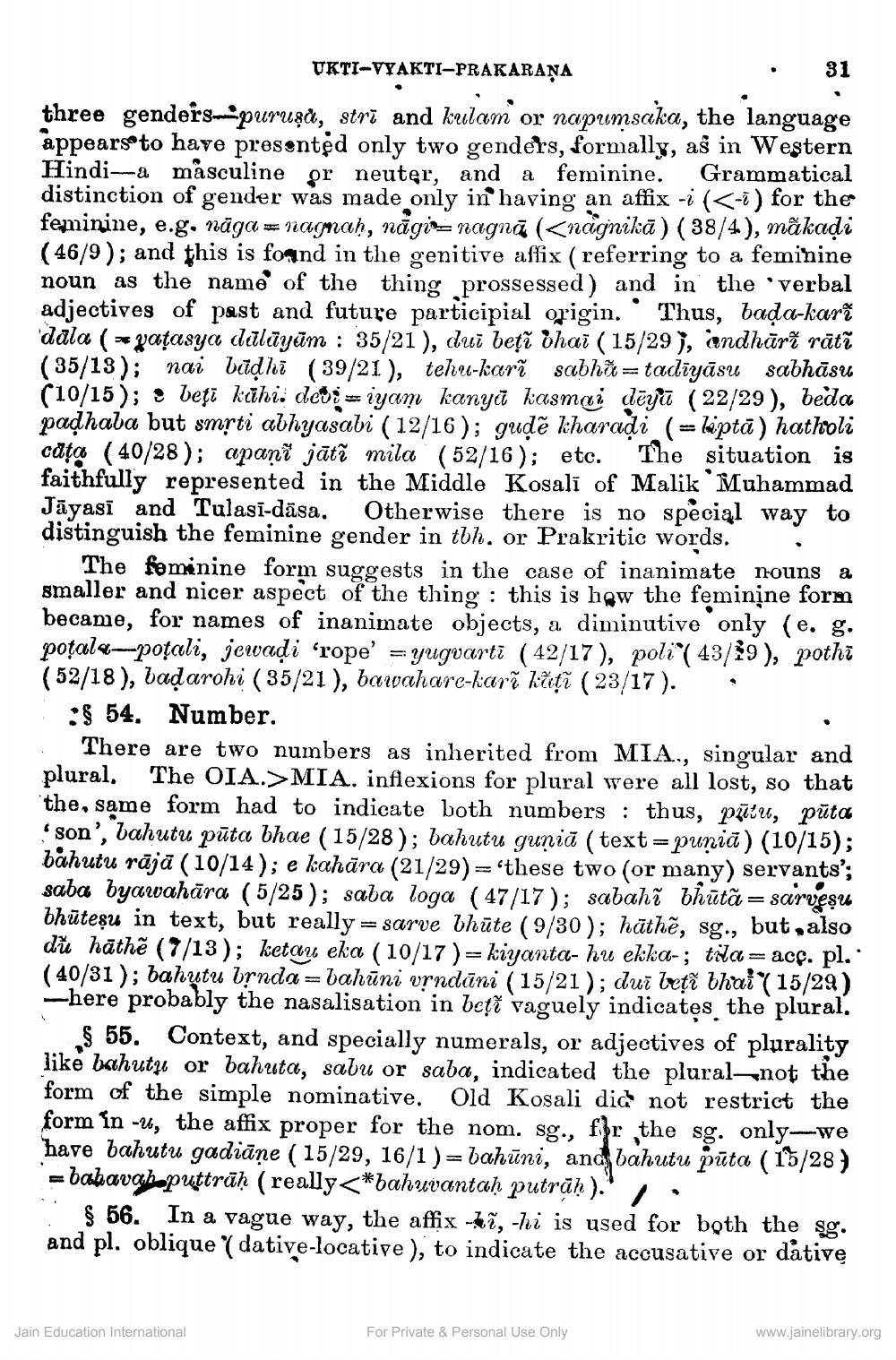________________
UKTI-VYAKTI-PRAKARANA
• 31 three genders--puruşå, strī and kulam or napumsaka, the language appears to have presented only two genders, formally, aš in Western Hindi--a masculine or neuter, and a feminine. Grammatical distinction of gender was made only in having an affix -i (<-7) for the feminine, e.g. nāga = nagnaḥ, nägin= nagna (<någnikā) (38/4), mãkadi ( 46/9); and this is fognd in the genitive affix (referring to a feminine noun as the name of the thing prossessed) and in the 'verbal adjectives of past and future participial origin. Thus, bada-kart dala (= pațasya dalāyām : 35/21), dui bețī dhai (15/29), andhūrī rātī (35/13); nai bidhi (39/21 ), tehu-karī sabhīt=tadīyāsu sabhāsu (10/15); · Veți kähi. dedi = iyam kanya kasmai dēyu (22/29), beda padhaba but smrti abhyasabi ( 12/16); gudē kharadi (=lptā) hatholi cata (40/28 ); apaņē jātī mila (52/16); etc. The situation is faithfully represented in the Middle Kosali of Malik Muhammad Jāyasī and Tulasi-dāsa. Otherwise there is no special way to distinguish the feminine gender in tbh, or Prakritic words. .
The feminine form suggests in the case of inanimate nouns a smaller and nicer aspect of the thing : this is how the feminine form became, for names of inanimate objects, a diminutive only (e. g. potala-potali, jewadi “rope' = yugvarti (42/17), poli*( 43/19 ), pothi (52/18), badarohi (35/21 ), bawahare-karī kūtī (23/17). ::$ 54, Number.
There are two numbers as inherited from MIA., singular and plural. The OIA.>MIA. inflexions for plural were all lost, so that the same form had to indicate both numbers : thus, pūtu, pūta
son', bahutu pūta bhae (15/28); bahutu guņiā (text=puniā) (10/15); bahutu rājā (10/14); e kahāra (21/29) = 'these two (or many) servants”; saba byawahāra (5/25); saba loga ( 47/17); sabahí bhūtã= sarvesu bhūteşu in text, but really = sarve bhūte (9/30); häthể, sg., but also dừ häthế (7/13); ketau eka (10/17 ) = kiyanta-hu ekka-; tila= acc. pl. ( 40/31 ); bahutu brnda = bahūni vrndāni (15/21 ); dui leti bhai (15/29) -here probably the nasalisation in beti vaguely indicates the plural.
$ 55. Context, and specially numerals, or adjectives of plurality like bahuthi or bahuta, sabu or saba, indicated the plural-not the form of the simple nominative. Old Kosali did not restrict the form în -2, the affix proper for the nom. sg., fifr the sg. only-we have bahutu gadiāņe (15/29, 16/1)=bahūni, and, bahutu pūta (15/28) = babavah puttrūḥ (really<*bahuvantah putrāḥ)." . : $ 56. In a vague way, the affix - 7, -hi is used for both the sg. and pl. oblique (dative-locative), to indicate the accusative or dåtive
Jain Education International
For Private & Personal Use Only
www.jainelibrary.org




